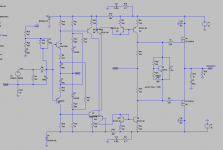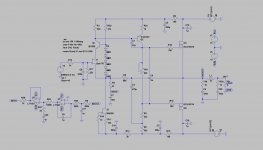I am watching but can not add much at this moment.
Let´s see how you solve the treble issue.
Just ordered the KSA... will use those with 6mA (Gareth's input on the bootstrap resistors was precious) and will lower Cdom to 22p and Clead to 10p.
If that does not do it, I will place a emitter follower in the miller loop.
In the meantime I am learning fast 🙂
Member
Joined 2009
Paid Member
Yes, they work fine without Rs
Now, would you care to explain what you mean by double bootstrap the Vbe multiplier ?
Now, would you care to explain what you mean by double bootstrap the Vbe multiplier ?
Member
Joined 2009
Paid Member
I haven't sketched it out so it might be needing some more thought, but the idea is to drop the current source and current mirrors used to provide current flow through the Vbe multiplier. Instead use a bootstrap to +ve rail and another to -ve rail. I haven't tried the double bootstrap myself so I am only suggesting it on a theoretical basis and because I think you'll find it interesting to consider it.
See here: http://www.diyaudio.com/forums/solid-state/47474-no-miller-cap-double-bootstrapping-amp.html
See here: http://www.diyaudio.com/forums/solid-state/47474-no-miller-cap-double-bootstrapping-amp.html
Double bootstrapping might enable a full rail swing of the VAS...
If we do not care for that, why is the floating ccs with mirrors so bad ?
I do see that the floating ccs tends to swing with the signal and using the Wilson approach mitigates that, but what is the real caveat ?
IMO the ccs and mirrors only purpose is to produce current for the Vbe multiplier.
The output stage is driven directly from the VAS so if the CCS is stiff enough there should be no interaction..... Or am I completely wrong ?
If we do not care for that, why is the floating ccs with mirrors so bad ?
I do see that the floating ccs tends to swing with the signal and using the Wilson approach mitigates that, but what is the real caveat ?
IMO the ccs and mirrors only purpose is to produce current for the Vbe multiplier.
The output stage is driven directly from the VAS so if the CCS is stiff enough there should be no interaction..... Or am I completely wrong ?
Here we have another solution (based on the 103 front end) that uses mirrors to feed the output stage.
I keep talking about the 103 but this is because it has one of the most clean detailed and extended sweet treble I ever heard.
The 103 is a "lean machine" so one needs a sub to give it a go in the bass, but it sounds sweeter then my denon poa6600, my quad and even my latest toy, the manley 300b monoblocks.
Off course, in this case the mirrors current is modulated by the signal but they drive the output stage...... so mirrors can be good in this position IMO.
I keep talking about the 103 but this is because it has one of the most clean detailed and extended sweet treble I ever heard.
The 103 is a "lean machine" so one needs a sub to give it a go in the bass, but it sounds sweeter then my denon poa6600, my quad and even my latest toy, the manley 300b monoblocks.
Off course, in this case the mirrors current is modulated by the signal but they drive the output stage...... so mirrors can be good in this position IMO.
Attachments
why don't you leave out the middle section and fold over the IPS, directly into the VAS mirror..??
Agree with MiiB, but you have to use different transistors for Q6, Q7, as well as for the mirrors - at full swing Q3, Q9 will also see too high Vcb (Vce) for BC3XX. Out of SOA...
Hi Ricardo, nice concept in #326.
But the spice models of the lateral mosfets that you use are useless in ltspice because they dont simulate the parasitic capacitances of the mosfet, so the mosfet speed will be much faster than in reality.
use instead Cordell 2sj162c 2sk1056c models, those are much closer to reality.
But the spice models of the lateral mosfets that you use are useless in ltspice because they dont simulate the parasitic capacitances of the mosfet, so the mosfet speed will be much faster than in reality.
use instead Cordell 2sj162c 2sk1056c models, those are much closer to reality.
Member
Joined 2009
Paid Member
I think you posted your double bootstrap over into the TGM8 thread - might be better here. The benefit of the double bootstrap is that you get a simpler topology (less to layout, less to build, less to debug and possibly less for the signal to go through) and you get more swing into the gates of the FETs. Lateral FETs have low transconductance so they need a lot of swing when you need them to flow a lot of current. The result is that you'll not be able to swing the output very close to the rails and so you lose headroom. The double bootstrap will allow you swing the gates further.
These simulations will allow you to explore a lot of things, but they won't tell you how it will sound of course.
These simulations will allow you to explore a lot of things, but they won't tell you how it will sound of course.
What is the problem Bigun ?
Loose some voltage and for that question the hard earned topology ?
Loose some voltage and for that question the hard earned topology ?
http://www.classiccmp.org/rtellason/transdata/2sc3601.pdf
these are awesome when you can get them
very nice devices... THx
😎🙂
-RNM
Member
Joined 2009
Paid Member
What is the problem Bigun ?
Loose some voltage and for that question the hard earned topology ?
Well yes that's quite perceptive ! often there is a bit of heartache to throw away the 'hard earned topology' which is why I threw it out as a crazy idea in case it struck a chord with RC. I do like the simplicity of bootstraps and I prefer not to lose voltage at high current either. So there you have it 🙂
Last edited:
Well, bootstraps are quite simple but they depend heavily on the used caps..... can we not use two CCS one on each rail side ?
why don't you leave out the middle section and fold over the IPS, directly into the VAS mirror..??
What do you mean by middle section Miib ?
Agree with MiiB, but you have to use different transistors for Q6, Q7, as well as for the mirrors - at full swing Q3, Q9 will also see too high Vcb (Vce) for BC3XX. Out of SOA...
Yes, this simulation is quite crude as is... please fell free to mod it according to your instructions.
Here we have another solution (based on the 103 front end) that uses mirrors to feed the output stage.
I changed the input to a jfet, this is to take away the need for input cap.
Hawksford IPS cascode, listening tests has proven more warm slam with the Hawksford cascode.
bootstrap VAS, drive the Lat-fets directly.
I,ts also possible to insert a mirror over the VAS transistor, This will increase open loop gain and improve the distortion, but I really see no gain as it already does something like 10 ppm
Hawksford IPS cascode, listening tests has proven more warm slam with the Hawksford cascode.
bootstrap VAS, drive the Lat-fets directly.
I,ts also possible to insert a mirror over the VAS transistor, This will increase open loop gain and improve the distortion, but I really see no gain as it already does something like 10 ppm
Attachments
I changed the input to a jfet, this is to take away the need for input cap.
Hawksford IPS cascode, listening tests has proven more warm slam with the Hawksford cascode.
bootstrap VAS, drive the Lat-fets directly.
I,ts also possible to insert a mirror over the VAS transistor, This will increase open loop gain and improve the distortion, but I really see no gain as it already does something like 10 ppm
Rather elegant

- Home
- Amplifiers
- Solid State
- Assemblage Power Amp

